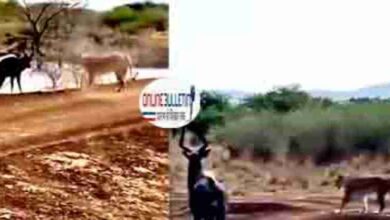जानवरों में तेजी से फैल रही लम्पी स्किन घातक बीमारी jaanavaron mein tejee se phail rahee lampee skin ghaatak beemaaree

©डॉ. सत्यवान सौरभ
परिचय– हिसार, हरियाणा.
ढेलेदार त्वचा रोग एक वायरल बीमारी है जो मवेशियों और भैंसों में लंबे समय तक रुग्णता का कारण बनती है। ये रोग पॉक्स वायरस लम्पी स्किन डिजीज वायरस (एलएसडीवी) के कारण होता है। यह पूरे शरीर में दो से पांच सेंटीमीटर व्यास की गांठों के रूप में प्रकट होता है, विशेष रूप से सिर, गर्दन, अंगों, थन (मवेशियों की स्तन ग्रंथि) और जननांगों के आसपास। गांठें धीरे-धीरे बड़े और गहरे घावों की तरह खुल जाती हैं।
इस साल ये रोग अप्रैल मई में पाकिस्तान में फैला तो अब बीते कुछ सप्ताह में ये हमारे देश में राजस्थान व गुजरात में तीन हजार से अधिक व पंजाब में चार सौ से अधिक पशुओं की मौत का कारण बना है। 2019 के विपरीत, जब एलएसडी के बांग्लादेश से भारत में प्रवेश करने और मध्य और दक्षिणी भारत में फैलने का संदेह था, इस बार के प्रकोप का स्रोत पाकिस्तान में माना जाता है।
ढेलेदार त्वचा रोग मवेशियों का एक वायरल संक्रमण है। मूल रूप से अफ्रीका में पाया जाता है, लेकिन अब यह मध्य पूर्व, एशिया और पूर्वी यूरोप के देशों में भी फैल गया है। लम्पी स्किन रोग के कारण पशुओं की खाल पर गिल्टियां बनने और तेज बुखार आने से उनकी मौत हो रही है। कमजोर पशु इस बीमारी की ज्यादा चपेट में आ रहे हैं। इस रोग से पीड़ित पशुओं में तेज बुखार आता है। ऐसे पशुओं की चमड़ी में गिल्टियां बनती हैं। ढेलेदार त्वचा रोग के हालिया भौगोलिक प्रसार ने अंतरराष्ट्रीय चिंता का कारण बना दिया है।
इस साल ये रोग अप्रैल मई में पाकिस्तान में फैला तो अब बीते कुछ सप्ताह में ये हमारे देश में राजस्थान व गुजरात में तीन हजार से अधिक व पंजाब में चार सौ से अधिक पशुओं की मौत का कारण बना है। 2019 के विपरीत, जब एलएसडी के बांग्लादेश से भारत में प्रवेश करने और मध्य और दक्षिणी भारत में फैलने का संदेह था, इस बार के प्रकोप का स्रोत पाकिस्तान में माना जाता है।
मवेशियों की विदेशी नस्लें, जैसे जर्सी, देशी नस्लों की तुलना में कम प्रतिरक्षा के कारण एलएसडी के प्रति अधिक संवेदनशील होती हैं। हालांकि, भैंस कम प्रभावित होती हैं क्योंकि उनकी रोग प्रतिरोधक क्षमता बेहतर होती है। अब तक, मनुष्यों या यहां तक कि बकरी और भेड़ को एलएसडीवी के हस्तांतरण का कोई मामला सामने नहीं आया है। संक्रमित जानवरों द्वारा उत्पादित दूध को भी मानव उपभोग के लिए सुरक्षित माना जाता है, जब तक कि इसे उबालकर या उपभोग से पहले पाश्चुरीकृत किया जाता है।
बरसात के मौसम के साथ इसके चल रहे प्रकोप मेल खाते हैं जब मच्छरों का प्रजनन बड़े पैमाने पर होता है और जानवर तनाव में रहते हैं। दफनाने की कोई नीति नहीं होने से, एलएसडी से मरने वाले मवेशियों के शव राजस्थान में कई स्थानों पर पड़े पाए गए हैं, जिससे संक्रमण फैलने की आशंका बढ़ गई है।
ढेलेदार त्वचा रोग एक वायरल बीमारी है जो मवेशियों और भैंसों में लंबे समय तक रुग्णता का कारण बनती है। ये रोग पॉक्स वायरस लम्पी स्किन डिजीज वायरस (एलएसडीवी) के कारण होता है। यह पूरे शरीर में दो से पांच सेंटीमीटर व्यास की गांठों के रूप में प्रकट होता है, विशेष रूप से सिर, गर्दन, अंगों, थन (मवेशियों की स्तन ग्रंथि) और जननांगों के आसपास। गांठें धीरे-धीरे बड़े और गहरे घावों की तरह खुल जाती हैं।
संक्रमित मवेशी भी अपने अंगों में सूजन की सूजन विकसित कर सकते हैं और लंगड़ापन प्रदर्शित कर सकते हैं। इस बीमारी के परिणामस्वरूप अक्सर पुरानी दुर्बलता, कम दूध उत्पादन, खराब विकास, बांझपन, गर्भपात और कभी-कभी मृत्यु हो जाती है। बुखार की शुरुआत वायरस से संक्रमण के लगभग एक सप्ताह बाद होती है। यह प्रारंभिक बुखार 41 डिग्री सेल्सियस (106 डिग्री फ़ारेनहाइट) से अधिक हो सकता है और एक सप्ताह तक बना रह सकता है।
यह मच्छरों, मक्खियों और टिक्कों और लार और दूषित पानी और भोजन के माध्यम से भी फैलता है। एलएसडी अफ्रीका और पश्चिम एशिया के कुछ हिस्सों के लिए स्थानिक है, जहां इसे पहली बार 1929 में खोजा गया था। दक्षिण पूर्व एशिया में एलएसडी का पहला मामला जुलाई 2019 में बांग्लादेश में दर्ज किया गया था। भारत में यह पहली बार अगस्त 2019 में मयूरभंज, ओडिशा से रिपोर्ट किया गया था। वायरस का कोई इलाज नहीं है, इसलिए टीकाकरण से बचाव ही नियंत्रण का सबसे प्रभावी साधन है।
भारत में, जहां दुनिया के सबसे ज्यादा 303 मिलियन मवेशी हैं, यह बीमारी सिर्फ 16 महीनों के भीतर 15 राज्यों में फैल गई है। इसका देश पर विनाशकारी प्रभाव हो सकता है, जहां अधिकांश डेयरी किसान या तो भूमिहीन या सीमांत भूमि मालिक हैं और दूध सबसे सस्ते प्रोटीन स्रोतों में से एक है।
एलएसडीवी का प्रकोप उच्च तापमान और उच्च आर्द्रता से जुड़ा होता है। यह आमतौर पर गीली गर्मी और शरद ऋतु के महीनों के दौरान अधिक प्रचलित होता है, विशेष रूप से निचले इलाकों या पानी के नजदीकी इलाकों में, हालांकि, शुष्क मौसम के दौरान भी प्रकोप हो सकता है। रक्त-पोषक कीट जैसे मच्छर और मक्खियां रोग फैलाने के लिए यांत्रिक वाहक के रूप में कार्य करते हैं। एक एकल प्रजाति वेक्टर की पहचान नहीं की गई है। एलएसडीवी के संचरण में कीटों की विशेष भूमिका का मूल्यांकन जारी है।
गांठदार त्वचा रोग के प्रकोप छिटपुट होते हैं क्योंकि वे जानवरों की गतिविधियों, प्रतिरक्षा स्थिति और हवा और वर्षा के पैटर्न पर निर्भर होते हैं, जो वेक्टर आबादी को प्रभावित करते हैं। यह रोग संक्रमित दूध से दूध पिलाने वाले बछड़ों में भी फैल सकता है। प्रायोगिक रूप से संक्रमित मवेशियों में, एलएसडीवी बुखार के 11 दिन बाद लार में, 22 दिनों के बाद वीर्य में और 33 दिनों के बाद त्वचा के नोड्यूल्स में पाया गया। मूत्र या मल में वायरस नहीं पाया जाता है। अन्य चेचक विषाणुओं की तरह, जिन्हें अत्यधिक प्रतिरोधी माना जाता है।
एलएसडीवी के खिलाफ पर्याप्त सुरक्षा सुनिश्चित करने के लिए, अतिसंवेदनशील वयस्क मवेशियों को सालाना टीका लगाया जाना चाहिए। लगभग 50% मवेशियों में टीकाकरण के स्थान पर सूजन (10–20 मिलीमीटर (1⁄2–3⁄4 इंच) व्यास) विकसित हो जाती है। यह सूजन कुछ ही हफ्तों में गायब हो जाती है। अधिकांश मवेशी प्राकृतिक संक्रमण से उबरने के बाद आजीवन प्रतिरक्षा विकसित करते हैं। इसके अतिरिक्त, प्रतिरक्षा गायों के बछड़े मातृ एंटीबॉडी प्राप्त करते हैं और लगभग 6 महीने की उम्र तक नैदानिक रोग के लिए प्रतिरोधी होते हैं।
अतिसंवेदनशील गायों से पैदा हुए बछड़े भी अतिसंवेदनशील होते हैं और उन्हें टीका लगाया जाना चाहिए। इन बीमारियों के खिलाफ टीकाकरण भारत के पशुधन स्वास्थ्य और रोग नियंत्रण कार्यक्रम के अंतर्गत आता है। गांठदार त्वचा रोग के उपचार के लिए कोई विशिष्ट एंटीवायरल दवाएं उपलब्ध नहीं हैं। उपलब्ध एकमात्र उपचार मवेशियों की सहायक देखभाल है। इसमें घाव देखभाल स्प्रे का उपयोग करके त्वचा के घावों का उपचार और द्वितीयक त्वचा संक्रमण और निमोनिया को रोकने के लिए एंटीबायोटिक दवाओं का उपयोग शामिल हो सकता है। प्रभावित जानवरों की भूख को बनाए रखने के लिए निवारक दवाओं का उपयोग किया जा सकता है।

Dr Satywan Saurabh
Lumpy skin fatal disease spreading rapidly in animals
Lumpy skin disease is a viral disease that causes prolonged morbidity in cattle and buffaloes. This disease is caused by the pox virus Lumpy Skin Disease Virus (LSDV). It appears as lumps of two to five centimeters in diameter all over the body, especially around the head, neck, limbs, udder (mammary gland of cattle) and genitals. The lumps gradually open up like larger and deeper sores.
This year, this disease spread in Pakistan in April-May, so now in the last few weeks it has caused the death of more than three thousand animals in our country in Rajasthan and Gujarat and more than 400 in Punjab. Unlike in 2019, when LSD was suspected to have entered India from Bangladesh and spread to central and southern India, this time the source of the outbreak is believed to be in Pakistan.
Lumpy skin disease is a viral infection of cattle. Originally found in Africa, but now it has also spread to countries in the Middle East, Asia and Eastern Europe. Due to lumpy skin disease, the animals are dying due to the formation of lumps on their skins and high fever. Weak animals are more vulnerable to this disease. High fever occurs in animals suffering from this disease. Noises are formed in the skin of such animals. The recent geographic spread of lumpy skin disease has caused international concern.
This year, this disease spread in Pakistan in April-May, so now in the last few weeks it has caused the death of more than three thousand animals in our country in Rajasthan and Gujarat and more than 400 in Punjab. Unlike in 2019, when LSD was suspected to have entered India from Bangladesh and spread to central and southern India, this time the source of the outbreak is believed to be in Pakistan.
Foreign breeds of cattle, such as the Jersey, are more susceptible to LSD than native breeds because of their lower immunity. However, buffaloes are less affected as they have better disease resistance. So far, there have been no reported cases of transfer of LSDV to humans or even goats and sheep. Milk produced by infected animals is also considered safe for human consumption, as long as it is boiled or pasteurized before consumption.
Its ongoing outbreaks coincide with the rainy season when mosquito breeding is rampant and animals remain under stress. With no burial policy, carcasses of cattle that died of LSD have been found lying at several places in Rajasthan, raising the possibility of spreading the infection.
Lumpy skin disease is a viral disease that causes prolonged morbidity in cattle and buffaloes. This disease is caused by the pox virus Lumpy Skin Disease Virus (LSDV). It appears as lumps of two to five centimeters in diameter all over the body, especially around the head, neck, limbs, udder (mammary gland of cattle) and genitals. The lumps gradually open up like larger and deeper sores.
Infected cattle may also develop inflammatory swellings in their limbs and exhibit lameness. The disease often results in chronic debility, low milk production, poor growth, infertility, miscarriage and sometimes death. Fever begins about a week after infection with the virus. This initial fever may exceed 41 °C (106 °F) and may persist for up to a week.
It is also spread through mosquitoes, flies and ticks and through saliva and contaminated water and food. LSD is endemic to parts of Africa and West Asia, where it was first discovered in 1929. The first case of LSD in Southeast Asia was reported in Bangladesh in July 2019. In India it was first reported in August 2019 from Mayurbhanj, Odisha. There is no cure for the virus, so prevention by vaccination is the most effective means of control.
In India, which has the world’s highest population of 303 million cattle, the disease has spread to 15 states in just 16 months. This can have devastating effects on the country, where most dairy farmers are either landless or marginal landowners and milk is one of the cheapest protein sources.
LSDV outbreaks are associated with high temperatures and high humidity. It is usually more prevalent during the wet summer and autumn months, especially in low-lying areas or areas close to water, although outbreaks can also occur during the dry season. Blood-feeding insects such as mosquitoes and flies act as mechanical carriers of disease transmission. A single species vector has not been identified. The specific role of insects in the transmission of LSDV is under evaluation.
Outbreaks of nodular skin disease are sporadic because they are dependent on animal activities, immune status, and wind and precipitation patterns, which affect vector populations. The disease can also spread to calves fed with infected milk. In experimentally infected cattle, LSDV was detected in saliva 11 days after fever, in semen after 22 days, and in skin nodules after 33 days. The virus is not found in urine or feces. Like other smallpox viruses, which are known to be highly resistant.
To ensure adequate protection against LSDV, susceptible adult cattle should be vaccinated annually. About 50% of cattle develop swelling (10–20 millimeters (1⁄2–3⁄4 in) diameter) at the site of vaccination. This swelling disappears within a few weeks. Most cattle develop lifelong immunity after recovering from natural infection. Additionally, calves of immune cows receive maternal antibodies and are resistant to clinical disease by about 6 months of age.
Calves born from susceptible cows are also susceptible and should be vaccinated. Vaccination against these diseases comes under the Livestock Health and Disease Control Program of India. There are no specific antiviral medications available for the treatment of nodular dermatitis. The only treatment available is supportive care of cattle. This may include treating skin wounds using wound care sprays and using antibiotics to prevent secondary skin infections and pneumonia. Preventive medications can be used to maintain the appetite of affected animals.














